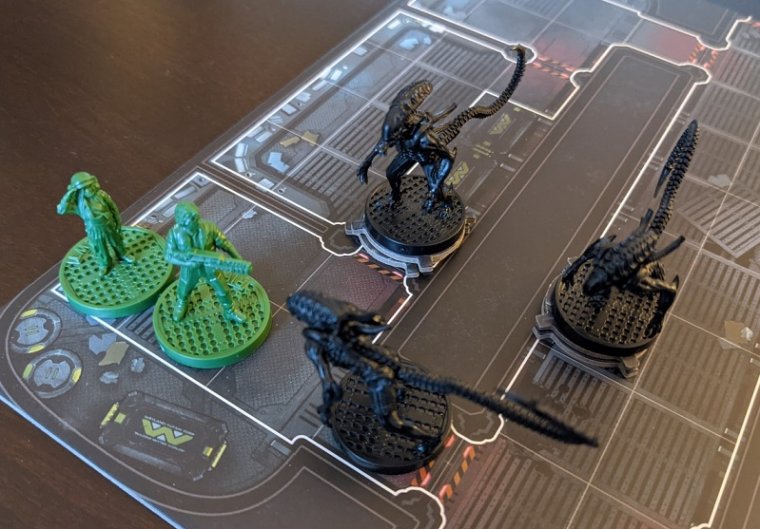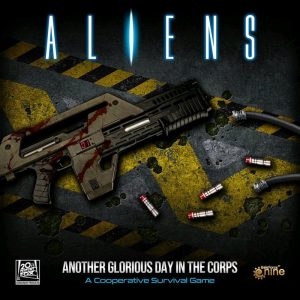Game over, man! —
Sadly, this cardboard adaptation could be better.
Charlie Theel
–

Enlarge / Ripley defending Newt.
Welcome to Ars Cardboard, our weekend look at tabletop games! Check out our complete board gaming coverage at cardboard.arstechnica.com.
Aliens: Another Glorious Day in the Corps is a peculiar release. Aliens, James Cameron’s follow-up to the sci-fi classic Alien is frankly one of the best action films ever made, so the excitement around this new cardboard adaptation is not surprising. The problem? We’ve seen it all before.
Aliens first received a tabletop implementation with a strong 1989 design published by Leading Edge. The spirit of the film was further embodied in Games Workshop’s classic Space Hulk, a game that was Aliens in all but name. Space Hulk influenced hundreds of tabletop dungeon crawlers since, each paying homage to their predecessors and re-wrapping that core tense experience with minute deviations.

So Aliens: Another Glorious Day in the Corps is already facing a challenge: how to be something new? Designer Andrew Haught realized that hurdle and introduced a seemingly unique central mechanism called the “endurance deck.” Everything else in this game is secondary. The plastic miniatures depicting Hicks, Ripley, and a score of aliens are all background. The fog of war blips, clearly influenced by Space Hulk, are just another tool. The lovingly crafted graphic design that covers every square inch of this game is simply veneer.
But the endurance deck is the game’s lifeblood. Players control multiple marines, spending cards to fire their weapons and initiate special abilities. Even new equipment enters play through the deck. Occasionally, players trigger a negative event from this deck as well, adding to the sense of danger lurking around every corner.
In some ways, this system is sleek and clever. It condenses multiple ideas—equipment, events, and abilities—into a single mechanism, which saves table space and lowers the rules overhead.
Of even more significance is the thematic accomplishment. You exhaust cards from the endurance deck to pay for actions, sometimes removing them permanently from play. The number of cards waning over time represents your group’s decreasing morale and resources. The deck provides an overt sense of dread that escalates across the arc of play. It will often mimic the board state, supporting the tension as xenomorphs crawl out of the ductwork and surround your squad.
As you engage with the game, the endurance system instills a real sense of dread and atmosphere. Thematic mechanisms add meaning and subtlety to the experience, leading to a sense of satisfaction. The game even feels novel at times.
A major supporting peripheral is the “aim dial.” This round cardboard tracker ticks down when you fire a weapon, representing your dwindling resolve as you quickly fire off additional shots. It fully resets each round, but you have to weigh whether it’s worth the further actions, as it leaves your character less capable of defensive fire during the alien activation. It’s part of a structure that, over time, makes the game increasingly tense—even desperate. In terms of capturing the content of the film, it’s a wonderful idea.
But that’s looking at it from one perspective.
-
A mission map.
-
Marines in battle.
-
Player boards.
-
Vasquez holding the doorway.
-
Putting the minis together is not simple!
Another view is that the endurance system is overwrought. For Vasquez to fire her M65 Smart Gun, you have to remove three cards to pay the cost, then turn the aim dial to lower your aim stat, and finally roll a 10-sided die to check if your shot hits. Then you have the option to fire again, burning another card to repeat the process. You may need to interrupt your turn to reshuffle and reset the deck. Imagine doing this for multiple marines every single round.
Except some of these marines won’t fire their shotgun or pulse rifle. Instead, they will take a rest action, passing cards from the “exhaust pile” back into the bottom of the endurance deck and preserving your troop’s unit integrity. This will often be a stronger option than attacking, forcing you to balance action and inaction.
Thus, the game is almost entirely about manipulating the deck. This idea doesn’t feel tied into the more thematic elements of play, and it disengages you from the experience. Worse, it exposes a fundamental misunderstanding of what the game should be about.
A much stronger implementation would have seen the deck replenish as a reward for taking down large numbers of aliens. Drop more than one with automatic fire? Return a card from the exhaust pile. That would have actually tied the incentive system more strongly to the source material and embraced the enticing aspects of the film while still maintaining the thematic touchstones of the downward arc.
There’s simply no shaking the clunkiness here. It appears to be an iteration of the exhaustion system in the Kickstarter darling The 7th Continent, but a good iteration should streamline and enhance, neither of which happens here. That previous design had you expend cards to pay for actions and resulted in a fail state after you eventually reshuffled and worked your way through the deck a second time. It was clear and concise, as you only had to contend with a single draw and discard pile.
Another Glorious Day in the Corps uses a draw deck, an exhaust pile, and an out-of-game discard pile. These different sets can interact in various ways, and cards can reference different costs. You also have to insert a reshuffle tile at the bottom of the draw deck to properly manage endurance restoration.
After the exciting first impression of the art and miniatures wears off, the cumbersome realities of this mechanism take over. It can feel like you’re fighting a faceless enemy, battling for directorial control of the script as opposed to actually blasting xenomorphs in the face.
There are many other elements to this game. The miniatures are attractive, although they require painful assembly. The approach of using larger cardboard tiles instead of smaller modular rooms is commendable, as it decreases setup time substantially. The campaign system is entertaining and much stronger than the one-off “Bug Hunt” scenarios. The linked-scenario narrative parallels the film, and losing characters is permanent. Of special interest is the chance for soldiers to be captured and the option to embark on a side mission to rescue them from their new cocooned existence.
Some of this stuff is interesting; other parts are unfortunately less so. But the very essence of this game, and what separates it from its peers, is that endurance deck. As a consequence, the design struggles to make a case for itself. Its core mechanism was better accomplished in The 7th Continent. Its encapsulation of Aliens‘ claustrophobia was more strongly executed in 1989 with Space Hulk. Even its arc of play featuring decaying protagonist capabilities was more effective in the underrated Claustrophobia. This simply is not the novel accomplishment that we saw in other recent games like Nemesis.
What may salvage this game is the fact that there are surprisingly few options for fully cooperative games of this type. Most dungeon crawlers require a player to control the antagonists, a role which many dislike. Here, you and a group of friends can confront a terrifying foe side by side.
This is also the only current tabletop miniatures design to feature the Aliens intellectual property. There’s lots of fan service, and the script repeatedly features staples such as “game over, man!” and “they mostly come at night…mostly.”
That may be enough for some, even if the rest of the design is derivative.

